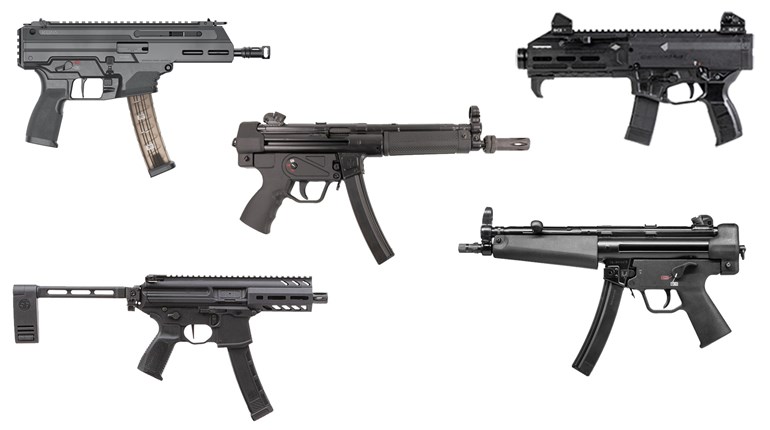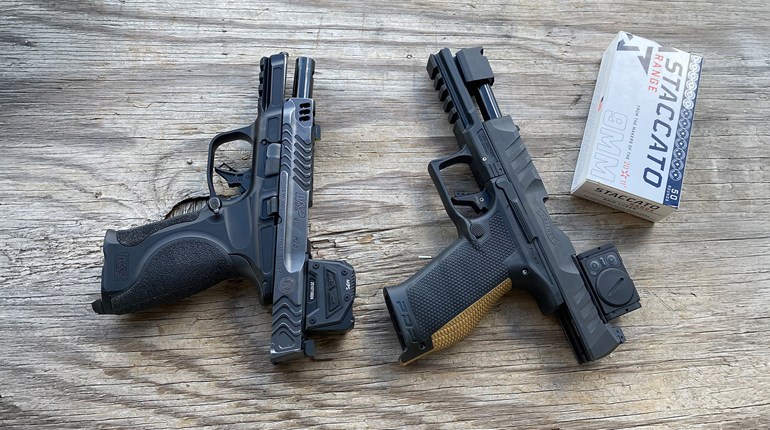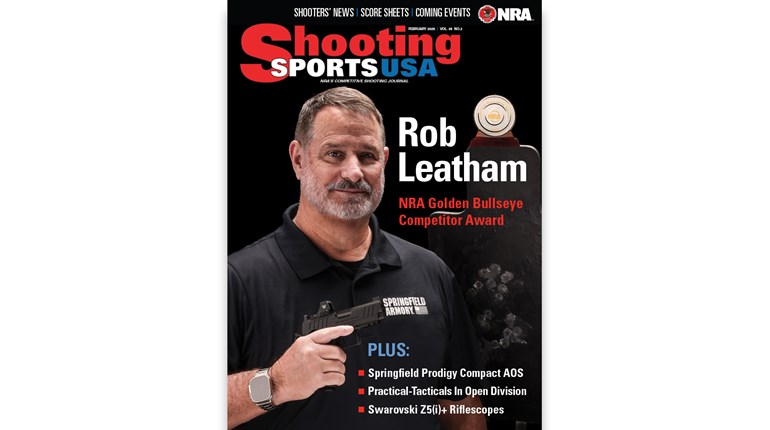
Although slimmer 9mm striker-fired pistols have been generating much buzz as the go-to for modern carry pistols, standard width, full-featured compact pistols are still holding their own as defensive and “do-it-all” pistols. Canik’s 15-round compact METE SF is such a gun. Its name comes from the Turkish word “mete” (pronounced “Met-Hey”), which means gallant or brave. METEs were officially launched in August of 2021, and with their refinements and additions, these could be considered unofficial “second generation” pistols over the company's original TP9 series. For example, all METE pistols include details such as a re-contoured frame and trigger guard, optics-cut slides and ambidextrous controls, things that are not found on the standard TP9. Overlapping elements do exist in all Canik models, and this can be confusing, but all compact and full-size Canik pistols operate off a simplified version of the Walther P99’s action: a system I wouldn’t hesitate to call proven and reliable.
Canik METE SF Overview
The Canik METE SF is a compact, polymer frame, striker-fired, semi-automatic double-stack handgun that comes standard with an optics-ready slide, ambidextrous slide stops, a Picatinny-rail dust cover and interchangeable backstraps. Save for an extra ¼-inch on the slide, the Canik METE SF’s overall size and shape is analogous to the 9mm Glock G19, the classic benchmark for a compact 9mm. METE SF pistols are available in all-black or in two-tone black-and-tan finishes. Canik also sells special editions with customized Cerakoted factory finishes.
Grip and Frame
The Canik METE SF’s grip angle is approximately 18 degrees and in-line with other handgun designs like the Smith & Wesson M&P M2.0 or the SIG Sauer P320. Its front strap and left and right sides are moderately textured with pebbling that won’t cut up clothes or hands. The backstrap is interchangeable and possesses a light texturing with square-shaped studs with the signature concave oval cut-outs first seen on the original Walther P99’s grip. The METE SF makes use of a reversible magazine catch with a square button, and it also includes ambidextrous slide stops–something I appreciate as a left-handed shooter. Compared to the original TP9 series, METE pistols have a re-contoured trigger guard to better accommodate a solid two-handed firing grip. Likewise, the trigger guard’s undercutting is more exaggerated. Shooters with larger hands may find the front strap a little crowded for their firing hand fingers, but with a length of 2⅛ inches, it’s right in line with most other compacts.
Slide, Sights and Optics Mounting System

Canik METE SF slides are nitrocarburized and then finished with uniform matte-black Cerakote. Besides the factory optics cut, METE SF slides are machined with front and rear serrations, though the forward set can be harder to grasp. A small pivoting loaded-chamber indicator is found right behind the breech-face, and the back of the slide has a red cocked-striker indicator–another Walther P99 design legacy. The METE SF’s iron sights are metal and serviceable, although basic. Though they have a standard white three-dot pattern, the dots on the rear sight differ in size from the front sight’s larger white dot which is helpful. The rear sight notch is plenty wide for practical use without straining shooter’s eyesight. Depending on which optic is installed, the factory sights may co-witness.
The most peculiar aspect about the METE SF’s optics cut is that it’s narrow and compatible with micro-dot footprints such like the Shield RMSc, Holosun-K or Trijicon RMR-CC. In fact, the Trijicon RMR-CC can be mounted directly. For the rest, Canik includes thin polymer RMSc plates, but mounting a Holosun-K still needs an adapter. Online comments say the Holosun-K can also be mounted directly, but other than the two screws, there aren’t any recoil bosses or other base supports.
I write “peculiar" because the Canik METE SF’s slide isn’t narrow as it’s not a “slim” gun. So why give this gun a micro-footprint, instead of something like a Trijicon RMR standard width footprint? Maybe not a deal breaker, but just peculiar. No one, after all, bats an eye to a Holosun EPS Carry mounted on Staccato C2 or Glock 19 for EDC. A potential reason for this choice is that Canik’s Mecanik MO1 optic uses the RMSc fooptrint.
The Canik METE SF Trigger
Canik’s out-of-the-box triggers have become one of the company’s signature cornerstones. Nicer triggers are generally associated with upmarket brands or models, whereas Canik has leveraged itself as a value proposition gun company offering “more gun for less money.” Regardless, the trigger on the METE SF’s is one of the gun’s best features. The part itself has nickel-plated internal components and a red bladed safety with a gently curved face. Prior to the trigger break, there is approximately 12mm of smooth pre-travel without any grittiness before arriving at the wall, which only takes a gradual increase of trigger-finger pressure to break. When it breaks, there’s no springy or spongy feel. This trigger will reset at approximately 5mm after being released from the rear. The trigger found on the METE SF is objectively pleasant. Using a digital pull weight scale, 20 trigger pulls averaged to a break of 3 pounds, 13 ounces.
Working the METE SF
 Prior to shooting, I mounted a Holosun EPS Carry on loan from Big Tex Ordnance. I used the provided polymer RMSc plate along with the Holosun-K to RMSc adapter that comes with the unit. The Canik instruction manual insists on using only their supplied hardware for mounting optics, but I chose to use another set of screws of the matching thread pitch whose heads had a better “fit” the deck of the EPS Carry.
Prior to shooting, I mounted a Holosun EPS Carry on loan from Big Tex Ordnance. I used the provided polymer RMSc plate along with the Holosun-K to RMSc adapter that comes with the unit. The Canik instruction manual insists on using only their supplied hardware for mounting optics, but I chose to use another set of screws of the matching thread pitch whose heads had a better “fit” the deck of the EPS Carry.
After zeroing the EPS Carry for 15 yards, I fired approximately 200 rounds of both factory and hand-loaded 9mm ammunition. Besides the 147-grain reloads, factory ammo used included 115-grain Blazer Aluminum FMJ, 115-grain Hornady Critical Defense JHPs, Staccato 2011’s new 124-grain FMJ rounds and the 147-grain Federal Syntech TSJ. This Canik had no issues cycling ammunition of either casing material. From the carry rounds tested, both the 115-grain Hornady and the 147-grain Syntech (which is ballistically identical to Federal Premium 147-grain HST) printed satisfactory groups.
Though 200 rounds is far from comprehensive, it’s a good start. The METE SF’s mechanical accuracy outclasses my own. The inclusion of a dot and an easy shooting trigger only helps the shooter, especially for precise shots. They definitely made it easy to blow out the X-ring of an NRA B8 target at 15 yards. Since the facility I shot at had strict rules and a set distance of 15 yards, I wasn’t able to run the battery of drills originally planned. So besides blowing out X-rings, I shot controlled pairs to get a feel for the gun’s movement. The manner in which the slide tracks and its felt recoil are similar to other handguns in the same size and weight class. The recoil spring is on the heavier side for cycling reliability, so there’s a tendency for subsequent shots to impact lower than point-of-aim due to the slide accelerating forward and causing the muzzle to dip.
The Takeaway
It’s true that slimmer, higher-capacity carry pistols have much to offer the wearer in terms of how they carry, but there’s also something to be said for a double-stack that handles like a duty-sized handgun. Canik is far from the only gunmaker fielding such guns in its catalogs. With its 4.2-inch barrel and compact double-stack grip, the Canik METE SF is sized appropriately and can easily work both roles, just like the benchmark Glock G19. Unlike the G19, shooters with smaller hands might have an easier time with the Canik’s grip. While I think the optics mounting system might be somewhat unconventional, though, it isn’t objectively hard to live with either. The only downside of how I installed that Holosun EPS Carry is that the sights don’t co-witness, but that also has an easy fix with the wide aftermarket of accessories available for these guns including mounting plates, sights, magazine base pads, grip inserts and other parts. Clearly, the METE SF’s trigger is its pièce de résistance. With its feature set and Walther P99 derived pedigree, it’s hard to remember that only a decade ago Caniks were thought of as mere budget-conscious entry-level guns.
Special thanks to Big Tex Ordnance for loaning me the Holosun EPS Carry sight.
Canik METE SF Specifications:
- Country Of Origin: Turkey
- Make: Canik
- Model: METE SF
- Caliber: 9mm
- Action: Striker-fired semi-automatic
- Magazine Capacity: 15 rounds, two 15-round magazines included
- Overall Length: 7.28 inches
- Width: 1.41 inches
- Height: 5.21 inches
- Weight: 28 ounces
- Frame Material: Polymer
- Slide Material: Steel with Cerakote finish
- Sights: 3-Dot metallic iron sights
- Optics-Ready: Yes
- Accessories: Hard-case, right handed IWB holster, magazine well, two polymer red-dot plates, tools, manual
- MSRP: $519
15-yard Accuracy Report:
|
Smallest Group |
Average Group |
Largest Group |
|
|
Hornady Critical Defense 115-grain JHP |
0.80 |
1.18 |
1.75 |
|
Staccato 2011 Range 124-grain FMJ |
1.00 |
1.06 |
1.25 |
|
Federal Syntech 147-grain TSJ |
1.00 |
1.25 |
1.50 |




































